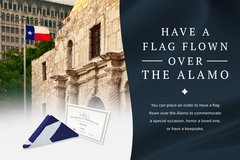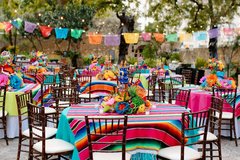For an event that attracts 3.5 million visitors and raises approximately $340 million each year for community charities, few outside of the San Antonio area know much about Fiesta. Let’s explore the history of this celebration and its ties to the Alamo.
What is Fiesta and What Does it Have to do with the Alamo?
Fiesta and the Alamo
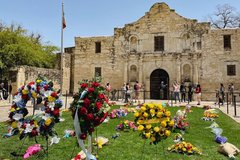
Before Fiesta became a city-wide, 10-day celebration, its origins were much humbler, starting with a single parade to honor the heroes of the Texas Revolution. In 1891, a group of San Antonio women, headed by Ellen Maury Slayden, decided to host a parade on April 21 for the anniversary of the Battle of San Jacinto. This parade, called the Battle of Flowers, was meant to honor the heroes of the Alamo and San Jacinto. The parade was filled with floats, horse drawn carriages, and bicycles — all decorated with flowers — and as the participants arrived at the front of the Alamo, they fought a “battle” by throwing flowers at one another. The parade continues to this day, though the tradition of throwing flowers has evolved into the laying of wreaths in front of the Alamo Church.
That first parade was such a success that by 1895 the festivities had grown into a week-long celebration which included street dances, festivals, carnivals, balls, and the coronation of a Fiesta Queen — followed a few years later by the choosing of a King.
Fiesta has taken place every year since, with the exception of 1918 (during World War I), 1942–45 (during World War II), and 2020 (due to COVID-19). It was during those interwar years that the tradition of the Pilgrimage to the Alamo was born.
In 1925, the Daughters of the Republic of Texas began the tradition of Pilgrimage, a procession of Texas Revolution descendants and military, civic, patriotic, and school groups, who make their way from the Municipal Auditorium to the Alamo to lay wreaths and listen to the names of the Alamo Defenders as they are called.
Today, Fiesta extends well beyond the Alamo with events such The Texas Cavaliers River Parade, Fiesta Flambeau, and countless others. To see the full line up, visit Fiesta San Antonio.
Fiesta Medals
Now that we’ve covered the history of Fiesta, you may be wondering, “But why does everyone jingle? What are those medals all about?” Fiesta is known as “the party with a purpose,” because it raises money for nonprofit organizations through special events and medal sales.
Much like Mardi Gras beads, Fiesta Medals are trinkets, baubles, a tangible connection to great memories — but please stay clothed!
So, where did the medal tradition come from?
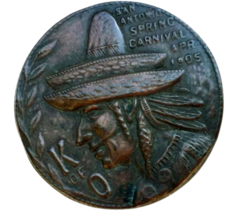
The tradition of medals began with coins, about the size of a half-dollar, handed out by King Antonio (another similarity to Mardi Gras) in 1946. In 1961, Joske’s department store began producing commemorative cardboard coin holders. Soon, Fiesta-revelers were wearing these coin holders around their neck or pinned to their shirts to show off their swag.
The details of the creation of the official Fiesta medal as we know it today is a little fuzzy. In 1971, King Antonio XLIX Charles G. Orsinger punched holes in the King’s coins and attached a red, white, and blue ribbon, which could be pinned onto one’s lapel. Another version places the beginning of the medal in 1980 with Lt. Col. Childers, who created the first military style medal on a ribbon.
Either way, by 1990, organizations throughout began producing and distributing their own Fiesta medals.
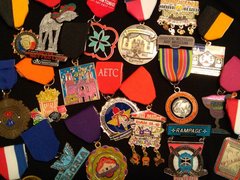
Today you will see Fiesta medals for businesses, schools, civic organizations, and more; some are used for fundraising, others for advertising, and some are just for fun. Medals are traditionally worn on sashes but can also be seen on shirts, vests, hats, etc. The only limitation is the wearer’s imagination!
To join our “Party for a Purpose” and get your own Alamo Fiesta Medal online or onsite at the Alamo Welcome Center.
Sources
“About Fiesta San Antonio,” Fiesta San Antonio
“History of Fiesta,” Fiesta San Antonio
“About Us,” Battle of Flowers
“Fiesta San Antonio,” Handbook of Texas Online, Mrs. Willard E. Simpson, Jr.
“History,” FiestaMedals.com
“The colorful history of Fiesta medals,” Rene A. Guzman, April 21, 2015, San Antonio Express News
“The Weird History Behind Fiesta Medals,” Jack Morgan, April 24, 2015, Texas Public Radio
“Archivist makes starling discovery: possibly the first Fiesta medal dating back to 1905,” Madalyn Mendoza, April 27, 2017, San Antonio Express News


